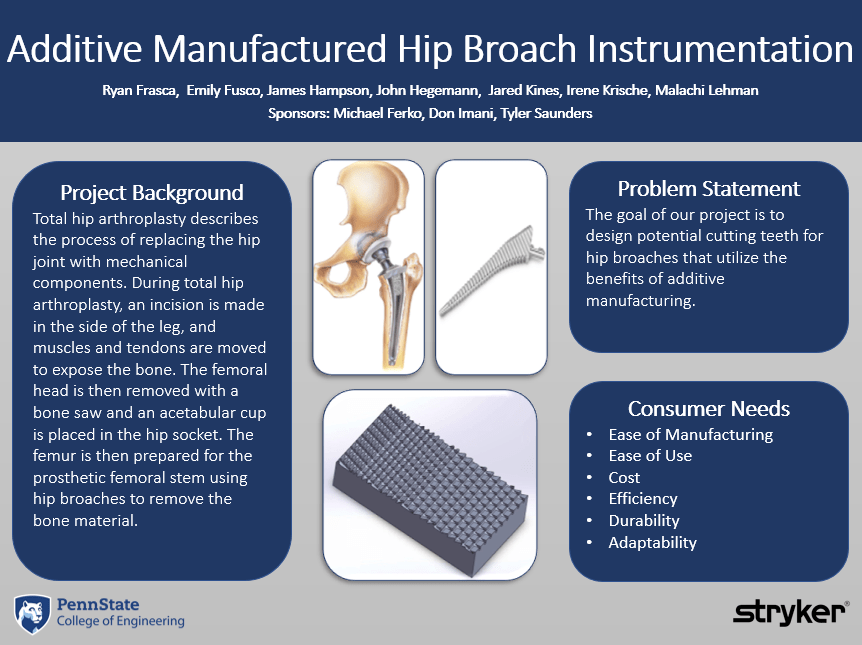The objective of this project is to design potential cutting teeth for hip broaches that utilize the benefits of additive manufacturing.

Sponsored by: Stryker – Michael Ferko, Don Imani, Tyler Saunders
Team Members
Ryan Frasca Emily Fusco James Hampson John Hegemann Jared Kines Irene Krische Malachi Lehman
Project Poster
Click on any image to enlarge.
Project Video
Project Summary
Overview
Striker is a medical technologies company who approached the Penn State Engineering Capstone Program with ambitions of expanding their surgical instruments market via application of current additive manufacturing capabilities. Specifically, Stryker wished to innovate manufacturing processes for total hip arthroplasty broaches, filing devices which expand a cavity in the femoral body during hip replacement surgery. Current broaches are manufactured via traditional methods of computer-numerical-control (CNC) machining and are both difficult and expensive to produce. Stryker tasked our group with evaluating the feasibility and potential advantages of creating hip broaches through metal additive manufacturing methods, providing a conclusion as to whether they should pursue such methods for large-scale production.
Objectives
Our objective was to compare broach teeth printed on a metal 3D-printing machine in terms of cost, cutting efficiency, and surface quality, to broach teeth manufactured through CNC-machining.
Approach
– Conduct weekly meetings with Stryker representatives to understand the assignments, receive regular feedback, and remain on task
– Evaluate the problems with CNC broach machining through research and sponsor interviews
– Attend a Stryker site visit to speak with representatives and generate a 3D printable tooth designs
– Select primary tooth designs via a Pugh Concept Selection Matrix
– Create CAD models of tooth designs on 2cm by 1cm rectangular coupons
– Develop a method to test cutting efficiency of the teeth designs wherein a Bose machine and custom 3D-printed apparatus are used to rub coupons against the surface of artificial bone
– Print tooth design coupons on a metal 3D printer and fasten to the custom-built testing apparatus
– Run tests and collect weight of matter removed from the artificial bone
– Determine cutting efficiency of broach teeth by comparing weight removed to distance the broach travelled
– Validate results by comparing cost, cutting efficiency, and surface quality to CNC machined teeth
Outcomes
– All broach teeth designs manufactured through metal 3D printing were found to be more efficient at cutting than the CNC machined designs
– In reducing the required labour and mechanized processes involved in manufacturing, the 3D printing broach coupons were also $X cheaper to produce per unit
– The tooth designs and cutting data will be used in Stryker for continued development of broaches within their additive manufacturing technologies branch




